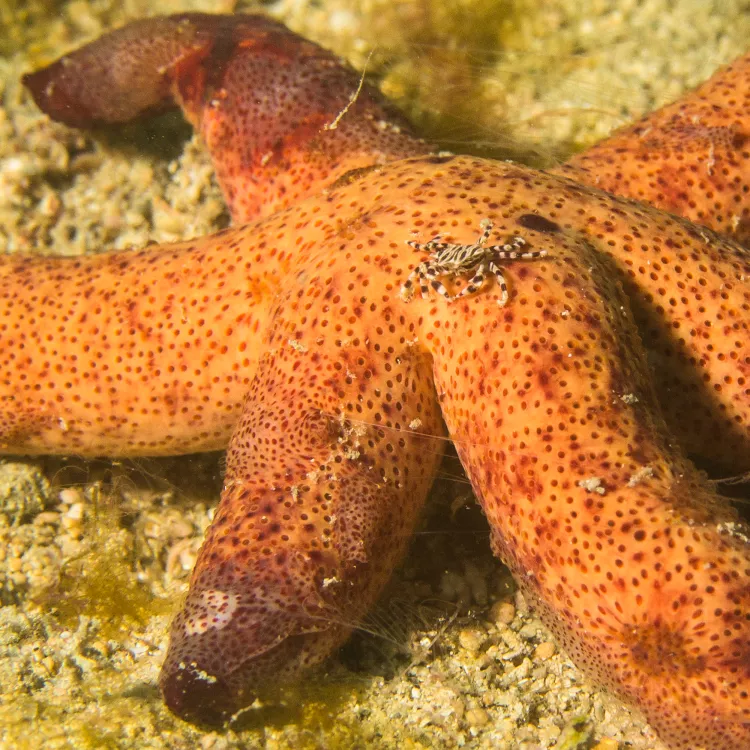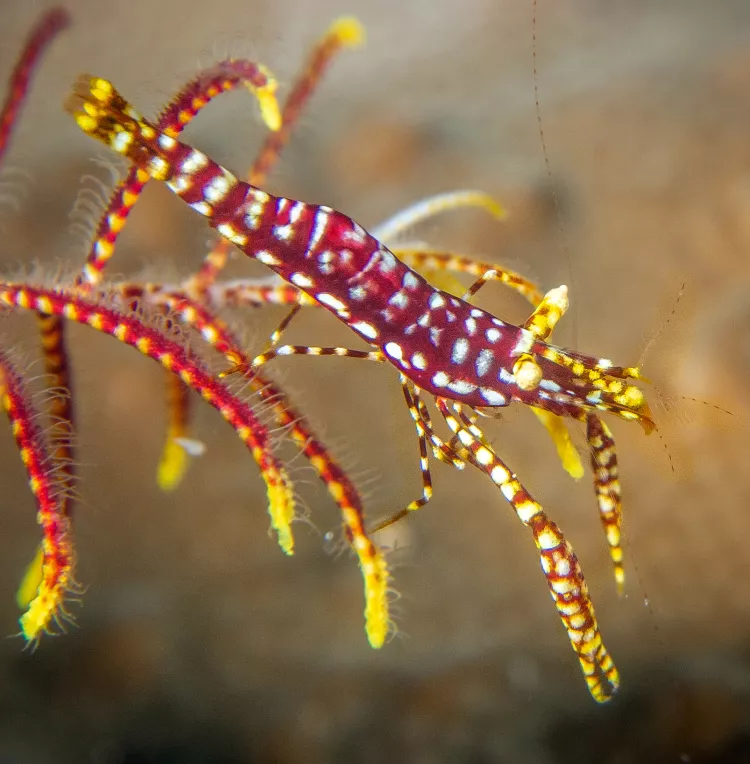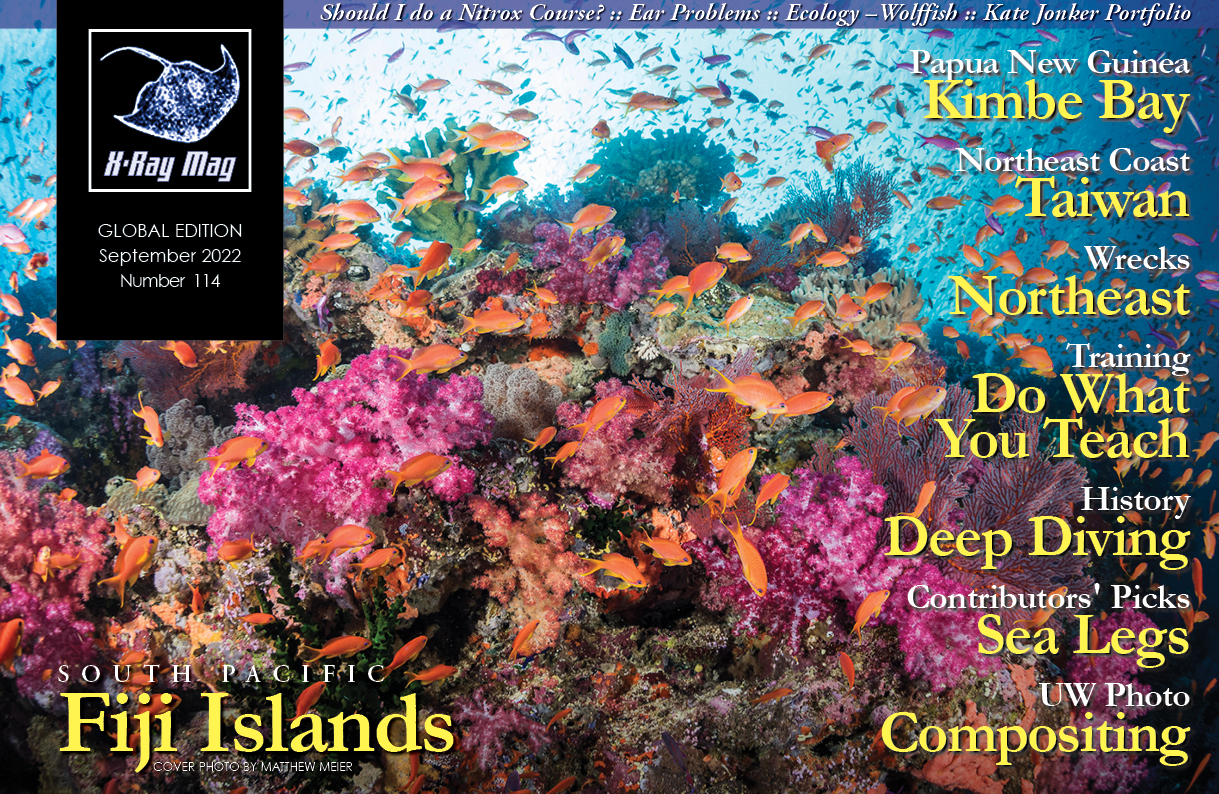We asked our contributors what their favorite underwater photos were of the legs, arms or tentacles of critters underwater. And they came back with a variety of subjects from curious crustaceans and cephalopods to jellyfish, sea stars, feather stars, frogfish and even people underwater.
Contributed by
(To see all the images, please scroll down to download the complete article)
X-Ray Mag contributors share their favorite images from the tropical waters of Papua New Guinea, Philippines, Indonesia, Egypt, Bahamas, Saba and Mexico to the temperate waters of Vancouver in Canada and the US East Coast.
Brightly Colored Appendages
Text and photos by Sheryl Checkman
While diving in Alor, Indonesia, at the Edge dive site, I came across this bright red-orange frogfish cleverly camouflaging itself against the equally bright colored coral (Photo 1). What I noticed first, before I actually saw the whole fish, were the white tips along the edges of its leg-like fins, as if it had just had a French manicure!
On Saba, I was poking around in the nooks and crannies of David’s Dropoff with my macro lens and found this scarlet reef hermit crab (also known as the red reef or red-legged hermit crab) peeking out from its shell (Photo 2). It is named for its bright red legs, which are contrasted by its yellow face and yellowish-green eyes that protrude from its face on yellow eyestalks. I am sure this crab was checking me out too!
On another dive on Saba, at Tent Reef, I found an arrow crab dancing in between the rock formations of the reef wall (Photo 3). Its bright gold legs with neon-blue claws offered a striking contrast against the gray and red of the wall. I photographed this crab with my macro lens, and I remember having a hard time holding still enough to keep it in focus.
At the Man ‘O War dive site, also on Saba, I captured a green sea turtle with my 8mm fisheye lens (Photo 4). In a hurry to switch ports for this dive, I inadvertently put the wrong port on my housing. I did not realize this until later, when I was viewing my photos and I could see the black circle of the lens port framing all my images. However, with some creative cropping, I was able to salvage the shot, focusing attention on the turtle’s intricately patterned arm-like flipper. Follow on Instagram: Instagram.com/sherylcheckman

Colorful Crustaceans
Text and photos by John A. Ares
Boxer crabs are amazing. (See Photo 1. Mosaic boxer crab.) These minuscule crabs hold small sea anemones in their claws for self-defense. The sea anemones benefit by being transported and exposed to more food sources than would be the case if they were stationary. Note that this was shot with a six-megapixel camera—an “old” Canon 10D—demonstrating megapixels are not the secret in the making of a quality photograph.
The hermit crab (Aniculus aniculus) in Photo 2 has wonderful, colorful legs. It does not decorate its shell with sea anemones as other species do. This species is active during the day and eats almost anything.
Porcelain crabs are one of those creatures that are hard to find at first. However, once you realize that they are associated with anemones, suddenly you will find them all over the place. They are frequently small, maybe 15mm wide. The individual in Photo 3 is filtering the water for plankton, using its feathery setae.
Underwater photographers go to the Indo-Pacific to see things that do not exist elsewhere in the world. Hairy squat lobsters are one of them. Maybe I have seen them twice in my life. To find them, you need to pay close attention to the local dive guides who know the underwater terrain, as this is “their backyard.” Visit: JohnAres.com

Legs for Locomotion
Text and photos by Larry Cohen
Divers, sailors and people that spend time on boats have an expression. They say people get their “sea legs” when they can handle rough seas and walk around the ship without getting sick. However, for an underwater photographer, “sea legs” can mean the actual legs of marine life or even a diver.
My dive buddy Renata Rojas was wearing dive gear with pink accents when we were getting ready for a shore dive in Dahab, Egypt. Her sea legs with pink fins made an intriguing subject for an over/under image (Photo 1).
The diving in Papua New Guinea off the liveaboard boat Febrina offers tremendous wide-angle and macro photo opportunities. For example, when diving Christine’s Reef, I captured a squat shrimp using its sea legs to walk on a coral head (Photo 2). Using an f/9 aperture, I could keep the shrimp in focus and still throw the background out of focus.
Blue Heron Bridge in Florida, USA, offers excellent macro photography subjects without getting on a boat. However, you do have to dive at slack tide, or the current can be powerful. During this dive, there were so many tiny creatures to take photos of that I stayed longer than I should have. As the current started getting very strong, I spotted an arrow crab using its many legs to move along the sea bottom. The arrow crab did not seem to be fazed by the current, but I had difficulty staying still to capture the image (Photo 3).
Cozumel is a Caribbean island ten miles off Mexico’s Yucatán Peninsula, across the water from Playa Del Carmen. Divers flock to Cozumel for the lush coral garden walls and swim-throughs. In addition, the island is home to 500 species of fish. The colorful walls are also crawling with invertebrate life. It was hard to miss a colossal channel clinging crab on one dive (Photo 4). Please visit: liquidimagesuw.com

Life on a Sea Star
Text and photos by Anita George-Ares
Real estate on a reef is at a premium, even on sea stars. The sea star shrimp comes in a variety of colors and lives on many species of sea stars. In Photo 1, the shrimp rests on an ambulacral groove on the underside of the sea star. Ambulacral grooves contain the tube feet of the sea star. The different textures and shades of blue exhibited by the shrimp and sea star make an interesting composition.
Different textures and shades of blue are also in the image of snails near an ambulacral groove (Photo 2). The parasitic snails (Thyca crystallina) obtain nutrients from the sea star’s hemal (blood vascular) system.
The red and white ovals on the sea star in Photo 3 are creeping comb jellies. Creeping comb jellies are unusual as they do not live in the water column where other species of comb jellies occur. The jellies make an interesting design on the sea star. At first, I thought that I had found a different species of sea star.
A zebra crab makes a home on a sea star that also hosts comb jellies (Photo 4). Long tentacles for capturing plankton extend from the comb jellies. Please visit: facebook.com/profile.php?id=100016947967639

Rhythmic Arms
Text and photos by Matthew Meier
The rhythmic movement of feather stars has fascinated me ever since I first laid eyes on them in Papua New Guinea almost 20 years ago. As a still photographer, I have tried to use the infinite shapes that motion generates to create artistic color combinations and abstract or geometric compositions of these amazing creatures—at times, capturing their entire form against an interesting background or otherwise coming in close to eliminate distractions from what caught my eye in the first place. When diving in the Indo-Pacific, especially with a macro lens on my camera, I always have one eye on the lookout for striking colors and uniquely patterned crinoids. Visit: MatthewMeierphoto.com

Leggy Beauties
Text and photos by Brandi Mueller
Decapods are an order of crustaceans that include crabs, lobsters and shrimp and are some of the ocean’s critters that have legs, which are perhaps more properly referred to as thoracic appendages. They have eight pairs of these; five pairs are considered legs, and the front three pairs are modified to assist in eating.
I find the best time to see these leggy beauties is on night dives when they emerge from their hiding places out into the open to feed. Some are more common during the day, like the banded coral shrimp in the Bahamas (Photo 4).
But I usually find spider and decorator crabs prancing around the coral at night, like the ones from the Red Sea and the Bahamas in Photo 1 and Photo 2. Both species can have highly decorated legs, usually with some sort of other marine life growing on them. Also, in the Bahamas at night, the larger, channel clinging crabs wander out into the open for a midnight snack (Photo 3). Visit: brandiunderwater.com

Evolution
Text and photos by Michael Rothschild, MD
As life evolved over billions of years, so did the way that animals get around. The earliest microorganisms just floated, waiting for a meal to drift by. But locomotion—for pursuit or for escape—required better gear. Water creatures developed fins and tails, which work well in a liquid world. But when our ancestors colonized dry land, they needed legs to move and support their weight against gravity.
Legs underwater seem out of place, but they have their roles. Negatively buoyant critters crawl rather than swim. And in some cases, legs evolved back to earlier forms—a whale’s flipper comes from its tetrapod ancestor’s forelimb, converting a leg to a more useful underwater structure (like a diver putting on fins).
The first photo is a hermit crab, with shiny legs and eyes standing out from a drab mussel bed. The second is the tip of a sea star; I watched with fascination as this normally sessile creature took a stroll across the ocean floor, dancing on tubular feet. The third image is a sea nettle, an Atlantic jellyfish floating in the shallows. And the fourth is my dive buddy demonstrating his great buoyancy skills by floating fins up. Please visit: dive.rothschilddesign.com

Crawling Crustaceans
Text and photos by Olga Torrey
As an underwater photographer, I am fascinated with the variety of marine life in all the locations I visit. In addition, I have always been interested in how crustaceans move along the reef, so I found concentrating on their legs necessary.
When diving in Cozumel, Mexico, I was lucky enough to see a spiny lobster crawling along the reef during the day; usually, they feed at night. These crustaceans navigate by using their sense of smell and by detecting the Earth’s magnetic field. The Caribbean spiny lobster is a decapod; it has ten legs and a spiny exoskeleton, which provides it some protection from potential predators. The motion of this creature’s many legs attracted my attention when I photographed it (Photo 1).
On the same dive in Cozumel, I spotted a hermit crab. Many photographers would not consider this crab a worthy subject but seeing the crab’s claws and legs move along the seabed, I knew it would make an interesting photo. Hermit crabs have ten legs, but only six legs are visible. These are walking legs. The hermit crab keeps its four other legs inside its shell, and these legs are much smaller than the walking legs. The front pair of legs have a larger pincer, which the crab uses for moving around and defending itself, as well as eating and drinking. Both front legs have thick layers of exoskeleton. (See Photo 2.)
Not all hermit crabs live in warm water. While diving Browning Pass Wall at Vancouver Island, British Columbia, Canada, I spotted another hermit crab. Because these animals take shells from other creatures, no two look alike. Hermit crabs need to find a more extensive shell body as they grow bigger. They will fight or kill another crab to take over a shell. (I have heard the same might be said of the human world, when looking for a rent-stabilized apartment in New York City!) This crab used its red legs to walk along the wall, carrying a stylish cover as its home. (See Photo 3.)
On the reefs of Papua New Guinea, there is so much life it is hard to decide whether to put a macro or wide-angle lens on one’s camera. When diving on Christine’s Reef off the liveaboard boat Febrina, I was glad that I had a macro lens on my camera when I spotted a coral shrimp using its legs to move along a crinoid. The pattern on this shrimp’s body and legs matched very closely to the design on the crinoid, making it hard to see. (See Photo 4.) Visit: fitimage.nyc





























